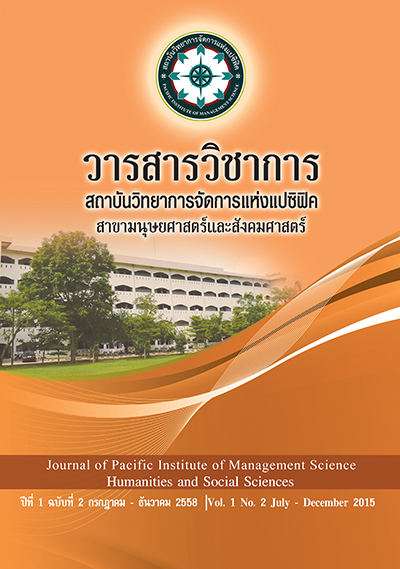กลยุทธ์การแข่งขันของธุรกิจสนามฟุตบอลในร่ม
Abstract
The purposes of this research were to study 1) service user behavior, 2) evaluated competitive strategy, 3) relationship between user behavior and competitive strategy, 4) model of Competitive Strategic of Indoor Football Field Business. Based on an accidental sampling sample size were 385 customers. Questionnaire was the study tool with likert scale 5 levels. Statistical treatments used included frequency, percentage, mean, standard deviation, ranking, Pearson Correlation, and Multiple Regression Analysis to created marketing model. The analysis was conducted by computer program.
1. The majority of Indoor Football Field service user were 21 – 25 years old 113 respondents (29.4%), education attend bachelor degree 163 respondents (42.3%), they are student 188 respondents (48.9%), average income per month 10,001 – 15,000 Baht 153 respondents (39.7%)
2. Finding indicated that majority of service user behavior in frequency of use in 3 months area more than 7 times were 149 respondents (38.7%), people who influent in decision making area were friend 137 respondents (40.8%), average expenditure per time in 3 months less than 1,000 Baht 151 respondents (39.3%)
3. Finding indicated that all area of studies became importance level of competitive strategic of indoor football field business and every area was high level. However the raking by mean in term of competitive strategic marketing were marketing promotion, services differentiate, indoor football field differentiate, location, lower cost, facility differentiate, and employees differentiate strategies, respectively.
4. Hypothesis tested found that the relative between service user behavior namely frequency of use in 3 months area, people who influent in decision making area, and average expenditure per time in 3 months area were low level positive direction
5. Competitive strategic of indoor football field business model = 2.570 + .309 marketing promotion + .281 facility differentiate + .278 location differentiate +.243 indoor football field differentiate with the significant level 89 %
References
กุญจนาท จันเจริญ, รชฎ ยอดนิล และสนุทร วิริยะศิริไพศาล. (2554). แผนธุรกิจการบริการให้เช่าสนำมฟตุบอลออนไลน์ วิทยาลัยการจัดการ. มหาวิทยาลัยมหิดล.
กรุงเทพธุรกิจออนไลน์ . (2554). ธุรกิจล่ำฝนับนสนำมหญ้ำเทียม. http://www.bangkokbiznews.com/home/news/ business/idea-design/news-list-1.php
กฤษณ มณีเทศ. (2553). พฤติกรรมและความพึงพอใจของผู้ใช้บริการ สนำมกีฬำเทศบาลนครเชียงใหม่ วิทยานิพันธุ์ บริหารธุรกิจมหาบัณฑิต มหาวิทยาลัยเชียงใหม่
เฉลิมพล เป็นมงคล, วรายุทธ มหิมา. (2555). การศึกษาความพึงพอใจของผู้ใช้บริการสนำมฟุตบอลหญ้าเทียม. ปริญญา วิทยาศาสตร์บัณฑิต (สาขาวิชาการจัดการอุตสาหกรรม) มหาวิทยาลัยราชภัฏอุดรธานี
ผู้จัดการออนไลน์ . (2553). แห่ผุดสนามฟุตบอลให้เช่า เกาะกระแสขาบอลฝันเป็นฮีโร่. http://www.manager.co.th/ iBizchannel/ViewNews.aspx?NewsID=9530000173327
วรัญญู รีรมย์ (2552). ความต้องการจัดบริการด้านการออกกำลังกายเพื่อสุขภาพของประชาชน. วิทยานิพนธ์ วิทยาศาสตร์ มหาบัณฑิต (การจัดการอุตสาหกรรม) สถาบันเทคโนโลยีพระจอมเกล้าพระนครเหนือ
วิวิธ เสนาวัตร. (2556). รูปแบบให้บริการที่มีประสิทธิผลของสนามฟุตบอลหญ้าเทียม ในร่มในเขตกรุงเทพมหานคร. วารสารสุทธิปริทัศน์ . มหาวิทยาลัยธุรกิจบัณฑิตย์ .
ศิริวัฒน์ ธิดา.(2555). ปัจจัยที่มีอิทธิพลต่อการตัดสินใจเลือกใช้บริการสนำมฟุตบอลให้เช่า ในเขตอำเภอเมือง จังหวัดเชียงใหม่. เศรษฐศาสตร์มหาบัณฑิต (เศรษฐศาสตร์ธุรกิจ) มหาวิทยาลัยธรรมศาสตร์ .
Michael E. Porter. (1990). The Competitive Advantage of Nations. Free Press, New York.
Yamane, Taro. (1967). Statistics: An introductory analysis. New York: Harper and Row.
Downloads
Published
Issue
Section
License
บทความที่ได้รับการตีพิมพ์เป็นลิขสิทธิ์ของ สถาบันวิทยาการจัดการแห่งแปซิฟิค
ข้อความที่ปรากฏในบทความแต่ละเรื่องในวารสารวิชาการเล่มนี้เป็นความคิดเห็นส่วนตัวของผู้เขียนแต่ละท่านไม่เกี่ยวข้องกับสถาบันวิทยาการจัดการแห่งแปซิฟิค และคณาจารย์ท่านอื่นๆในสถาบันฯ แต่อย่างใด ความรับผิดชอบองค์ประกอบทั้งหมดของบทความแต่ละเรื่องเป็นของผู้เขียนแต่ละท่าน หากมีความผิดพลาดใดๆ ผู้เขียนแต่ละท่านจะรับผิดชอบบทความของตนเองแต่ผู้เดียว







